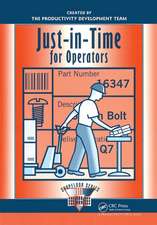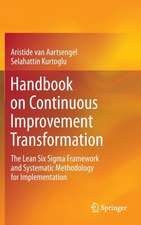Managing Open Innovation Technologies
Editat de Jenny S. Z. Eriksson Lundström, Mikael Wiberg, Stefan Hrastinski, Mats Edenius, Pär J. Ågerfalken Limba Engleză Hardback – 30 noi 2012
With valuable lessons to be learned from academic research and industrial experiences of e.g. Intel, Nokia, Philips Healthcare, small municipalities, e-learning platforms and user communities, this book focuses on some of the key dimensions of open innovation and open innovation technologies. It is divided into three themes: theme 1 deals with open innovation as it is in use today, including theoretical underpinnings and lessons from related research fields. Theme 2 analyzes the use of open innovation in organizations today in order to extract best practices. Theme 3 presents forward-looking theoretical research as well as practical future uses of open innovation. Each chapter addresses the particular topics by presenting experiences and results gained in real life projects and/or by empirical research, and clearly states its purpose and how readers are supposed to benefit from it.
Overall, the objectives of this book are to advance and disseminate research on systematic open innovation, and to make its results available to practitioners. Thus, the intended target audience includes the international academic community, industrial enterprises, and public authorities.
| Toate formatele și edițiile | Preț | Express |
|---|---|---|
| Paperback (1) | 562.28 lei 38-44 zile | |
| Springer Berlin, Heidelberg – 14 dec 2014 | 562.28 lei 38-44 zile | |
| Hardback (1) | 647.59 lei 6-8 săpt. | |
| Springer Berlin, Heidelberg – 30 noi 2012 | 647.59 lei 6-8 săpt. |
Preț: 647.59 lei
Preț vechi: 761.87 lei
-15% Nou
Puncte Express: 971
Preț estimativ în valută:
123.93€ • 128.03$ • 103.14£
123.93€ • 128.03$ • 103.14£
Carte tipărită la comandă
Livrare economică 26 martie-09 aprilie
Preluare comenzi: 021 569.72.76
Specificații
ISBN-13: 9783642316494
ISBN-10: 3642316492
Pagini: 316
Ilustrații: XVI, 300 p.
Dimensiuni: 155 x 235 x 25 mm
Greutate: 0.62 kg
Ediția:2013
Editura: Springer Berlin, Heidelberg
Colecția Springer
Locul publicării:Berlin, Heidelberg, Germany
ISBN-10: 3642316492
Pagini: 316
Ilustrații: XVI, 300 p.
Dimensiuni: 155 x 235 x 25 mm
Greutate: 0.62 kg
Ediția:2013
Editura: Springer Berlin, Heidelberg
Colecția Springer
Locul publicării:Berlin, Heidelberg, Germany
Public țintă
ResearchCuprins
Managing Open Innovation Technologies - Contemporary Best Practices.- Theme I: Motivations.- Open Source Software as Open Innovation: Experiences from the Medical Domain.- “It’s the Conversation, Stupid!” Social Media Systems Design for Open Innovation Communities.- Organisational Participation in Open Innovation Communities.- Open Innovation Technologies and Exploitative and Explorative Learning.- Open Innovation in Inter-Organisational Networks in the IT Industry.- Theme II: Best Practices.- Encouraging Open Community Innovation: Outils-Réseaux’s Modular Approach.- Open Source Technology in Intra-Organisational Software Development -Private Markets or Local Libraries.- Open Innovation in Practice: The Development of the IT Capability Maturity Framework.- Voluntary Contributors in Open Innovation Processes.- Creating Value through Open Innovation in Social E-learning.- Theme III: Moving Forward.- Overcoming Industrial Inertia by Use of Open Innovation Technologies.- Using Information Technology to Manage Diverse Knowledge Sources in Open Innovation Processes.- Pico-Jobs as an Open Innovation Tool for Utilising Crowdsourcing.- Open Strengths and Weaknesses of IT User Innovation: Evidence from Three Cases.- Open Service Innovation in Health Care: What can we Learn from Open Innovation Communities?.- How Open is Open Innovation? Considering, Adapting and Adopting User Knowledge and Competence in the Solution Space.- The Future of Open Innovation Technologies and its Management.
Recenzii
From the reviews:
“This book presents summaries of research on innovation that may help organizations advance their goals incrementally through innovative techniques. … best lends itself to a highly technical, research-focused audience. … Researchers and academic readers may find ideas in the book that are worth trying out or researching further.” (Ilya Yakovlev, Computing Reviews, January, 2014)
“This book presents summaries of research on innovation that may help organizations advance their goals incrementally through innovative techniques. … best lends itself to a highly technical, research-focused audience. … Researchers and academic readers may find ideas in the book that are worth trying out or researching further.” (Ilya Yakovlev, Computing Reviews, January, 2014)
Notă biografică
Jenny Eriksson Lundström is Senior Researcher at NITA – the Swedish IT-User Centre – and Lecturer of Information Systems at the Department of Informatics and Media, Uppsala University, Sweden. For several years, she has been researching information technology and knowledge management, with a multidisciplinary perspective on IT and innovation.
Mats Edenius is a Professor of Information Systems in the Department of Informatics and Media at Uppsala University. His research interests lie within the areas of information technology and knowledge management.
Stefan Hrastinski is Associate Professor of Media Technology at KTH Royal Institute of Technology, Sweden. He is also affiliated with the Swedish IT-User Centre and the Department of Informatics and Media at Uppsala University. His main research interests are online learning, collaboration, and innovation in organizational and educational settings.
Mikael Wiberg is Full Professor in the Department of Informatics and Media at Uppsala University where he holds the chair in HCI – Human Computer Interaction. Prior to this position, Wiberg held a position as Research Director for the Umeå Institute of Design, Sweden.
Pär J. Ågerfalk is Full Professor in the Department of Informatics and Media at Uppsala University where he holds the Chair in Information Systems. He held prior positions at Örebro University, Lero, the Irish Software Engineering Research Centre, Jönköping International Business School, and the University of Limerick. His research interests include information systems development, open source software, and global software development.
Mats Edenius is a Professor of Information Systems in the Department of Informatics and Media at Uppsala University. His research interests lie within the areas of information technology and knowledge management.
Stefan Hrastinski is Associate Professor of Media Technology at KTH Royal Institute of Technology, Sweden. He is also affiliated with the Swedish IT-User Centre and the Department of Informatics and Media at Uppsala University. His main research interests are online learning, collaboration, and innovation in organizational and educational settings.
Mikael Wiberg is Full Professor in the Department of Informatics and Media at Uppsala University where he holds the chair in HCI – Human Computer Interaction. Prior to this position, Wiberg held a position as Research Director for the Umeå Institute of Design, Sweden.
Pär J. Ågerfalk is Full Professor in the Department of Informatics and Media at Uppsala University where he holds the Chair in Information Systems. He held prior positions at Örebro University, Lero, the Irish Software Engineering Research Centre, Jönköping International Business School, and the University of Limerick. His research interests include information systems development, open source software, and global software development.
Textul de pe ultima copertă
Open innovation increases the profit of companies and organizations via the input and the adoption of new ideas that are transformed into new processes, products, and services. Yet, how do we ensure that adopters of such innovations focus on relevant problems and use appropriate methods? How should we manage open innovation technologies? How can we exploit distributed knowledge and inventions? And how can we promote them successfully on the market?
With valuable lessons to be learned from academic research and industrial experiences of e.g. Intel, Nokia, Philips Healthcare, small municipalities, e-learning platforms and user communities, this book focuses on some of the key dimensions of open innovation and open innovation technologies. It is divided into three themes: theme 1 deals with open innovation as it is in use today, including theoretical underpinnings and lessons from related research fields. Theme 2 analyzes the use of open innovation in organizations today in order to extract best practices. Theme 3 presents forward-looking theoretical research as well as practical future uses of open innovation. Each chapter addresses the particular topics by presenting experiences and results gained in real life projects and/or by empirical research, and clearly states its purpose and how readers are supposed to benefit from it.
Overall, the objectives of this book are to advance and disseminate research on systematic open innovation, and to make its results available to practitioners. Thus, the intended target audience includes the international academic community, industrial enterprises, and public authorities.
With valuable lessons to be learned from academic research and industrial experiences of e.g. Intel, Nokia, Philips Healthcare, small municipalities, e-learning platforms and user communities, this book focuses on some of the key dimensions of open innovation and open innovation technologies. It is divided into three themes: theme 1 deals with open innovation as it is in use today, including theoretical underpinnings and lessons from related research fields. Theme 2 analyzes the use of open innovation in organizations today in order to extract best practices. Theme 3 presents forward-looking theoretical research as well as practical future uses of open innovation. Each chapter addresses the particular topics by presenting experiences and results gained in real life projects and/or by empirical research, and clearly states its purpose and how readers are supposed to benefit from it.
Overall, the objectives of this book are to advance and disseminate research on systematic open innovation, and to make its results available to practitioners. Thus, the intended target audience includes the international academic community, industrial enterprises, and public authorities.
Caracteristici
Analyzes the benefits of open innovation in detail Presents challenges and solutions in adopting open innovation technologies Captures best practices and experiences from real-life industrial open innovation projects Includes supplementary material: sn.pub/extras













